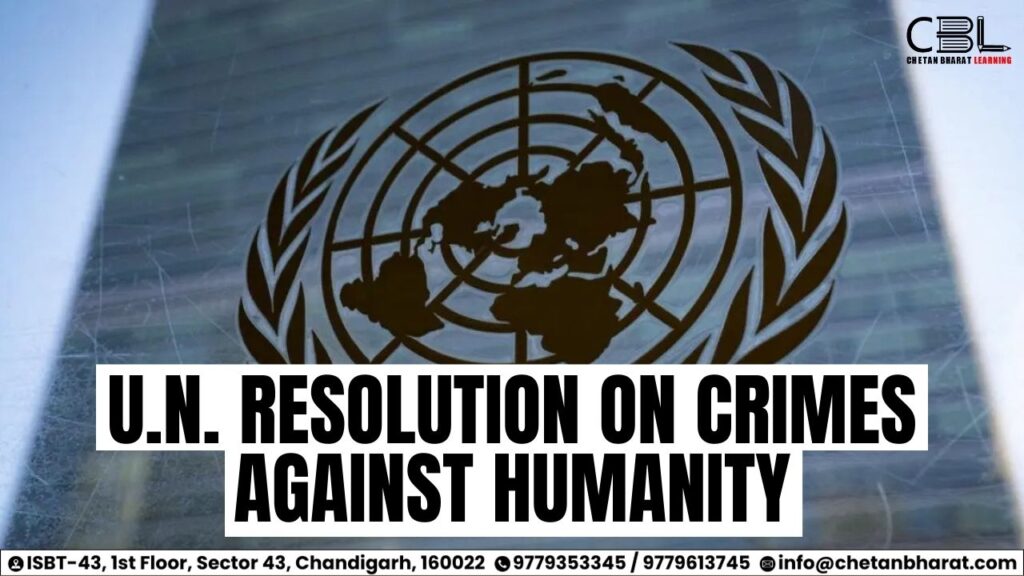
Important for UPSC, State PCS
Prelims: U.N. Resolution on Crimes Against Humanity
Mains: General Studies Paper 2 – United State . International Relation .
Context-
The U.N. The General Assembly’s legal committee adopted a resolution to begin negotiations for a treaty on preventing and punishing crimes against humanity.
U.N. resolution on Crimes Against Humanity
– The resolution was supported by 98 countries, including Mexico and Gambia, and is seen as necessary to address the gap in international law on crimes against humanity (a topic not covered by existing treaties on war crimes, genocide, and torture).
– While the International Criminal Court (ICC) prosecutes war crimes, genocide, and crimes against humanity, it lacks jurisdiction in many countries.
1. The new treaty would address crimes against humanity in countries outside the ICC’s jurisdiction.
– Importance : The resolution is seen as a significant step in international law, addressing impunity for crimes against humanity in places like Ethiopia, Sudan, Ukraine, Gaza, and Myanmar.
Need for a Treaty on Crimes Against Humanity
- Addressing a Legal Gap: Existing international law, such as the Rome Statute of the International Criminal Court, primarily addresses crimes committed during armed conflict. However, many heinous crimes against humanity occur outside the context of war, such as genocide, persecution, and apartheid.
- Comprehensive Legal Framework: Offers victims pathways for justice and assists countries in incorporating crimes against humanity into national legal systems.
- Fostering Global Cooperation: Enables international collaboration, such as through mutual legal assistance and extradition agreements.
Crimes Against Humanity
- Brief: These are crimes committed as part of a widespread attack against any civilian population.
- Examples: Includes acts like murder, extermination, enslavement, torture, rape, sexual violence, sexual slavery, and other inhumane acts.
- Elements
- Physical: The act must involve one of the following:
- Murder, extermination, enslavement, deportation, imprisonment, torture
- Grave sexual violence, persecution, enforced disappearance, apartheid, or other inhumane acts.
- Contextual: The act must be part of a widespread or systematic attack on a civilian population, not just isolated incidents.
- Mental: The perpetrator must be aware that their actions are part of a larger attack against civilians.
- No Need for Armed Conflict: Crimes against humanity can occur during times of peace, unlike war crimes that are linked to armed conflict.
- Target: Unlike genocide, crimes against humanity are not aimed at a specific group but any civilian population.
- Physical: The act must involve one of the following:
- Challenges in Prosecution
- Prosecuting crimes against humanity poses significant challenges.
- These include gathering sufficient evidence, ensuring witness protection, and navigating political complexities.
- Additionally, the principle of state sovereignty can sometimes hinder international intervention and justice.
- Prosecuting crimes against humanity poses significant challenges.
Recent Examples
- Recent history has seen numerous instances of crimes against humanity.
- The conflict in Syria, the Rohingya crisis in Myanmar, and the situation in Darfur, Sudan, are notable examples where widespread and systematic attacks against civilian populations have been documented.
Role of the International Community
- The international community plays a crucial role in addressing crimes against humanity.
- Organizations like the United Nations and the International Criminal Court work to investigate, prosecute, and prevent these crimes.
- International Criminal Court (ICC): The ICC is the permanent court responsible for prosecuting crimes against humanity.
- National Courts: Countries that incorporate crimes against humanity into their criminal law can also prosecute these crimes
Existing Mechanisms to Prevent Crimes Against Humanity
– International Humanitarian Laws:
1. Geneva Conventions (1949): Protects civilians and non-combatants in armed conflicts.
2. Biological Weapons Convention (1972): Prohibits biological weapons.
3. Chemical Weapons Convention (1993): Bans chemical weapons.
4. Rome Statute (1998): Establishes the ICC to prosecute genocide, war crimes, and crimes against humanity.
– Framework in India:
1. Article 51: Promotes international peace and adherence to international law.
CBL Practice Questions for Prelims –
Consider the following statements regarding the United Nations resolution on Crimes Against Humanity:
- The resolution aims to address the gap in international law concerning crimes against humanity, as existing treaties only cover war crimes, genocide, and torture.
- The International Criminal Court (ICC) can prosecute crimes against humanity in any country, regardless of the country’s consent or jurisdiction.
- The resolution has been supported by 98 countries, including Mexico and Gambia, and is seen as a necessary step to address impunity for crimes against humanity in regions like Ethiopia, Sudan, and Myanmar.
- The new treaty introduced by the resolution will allow for the prosecution of crimes against humanity in countries outside the jurisdiction of the International Criminal Court (ICC).
Which of the above statements are correct?
(A) 1, 3, and 4 only
(B) 2 and 4 only
(C) 1, 3, and 4 only
(D) 1 and 4 only
Answer:– (A) 1, 3, and 4 only
CBL Mains Practice Question –
“The recent United Nations resolution on Crimes Against Humanity, supported by 98 countries, including Mexico and Gambia, addresses a significant gap in international law. Critically analyze its implications for global justice, the limitations of existing international mechanisms, and the challenges it may face in implementation.”




Leave a Reply
You must be logged in to post a comment.